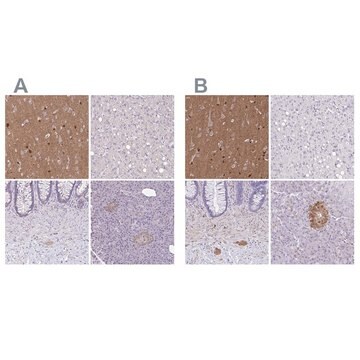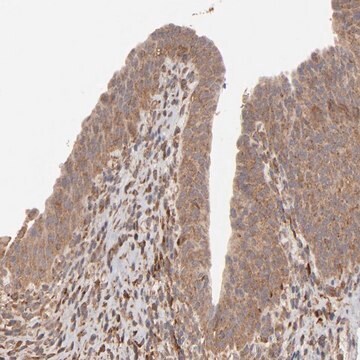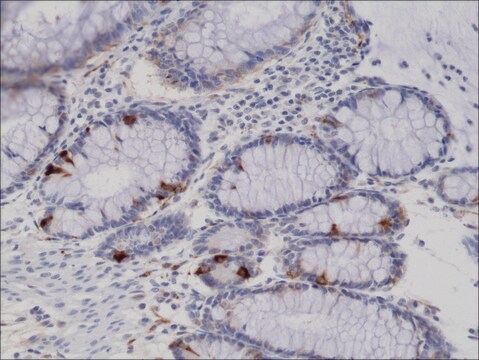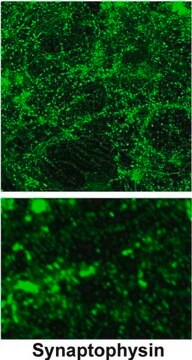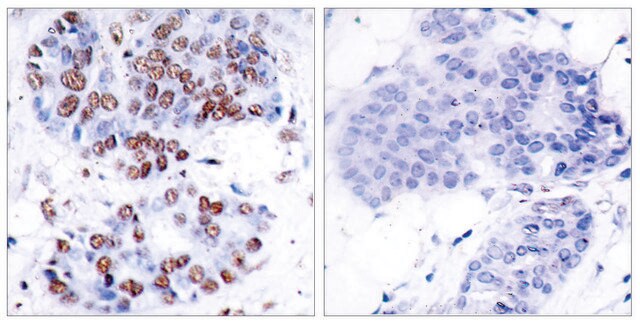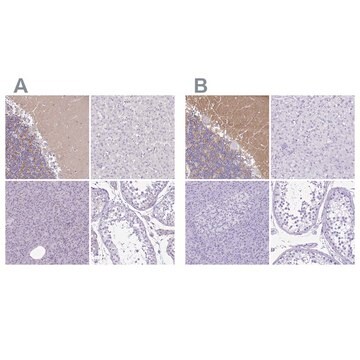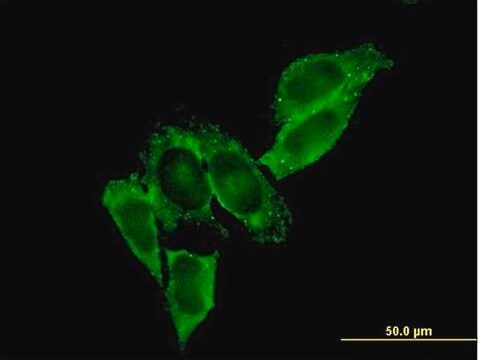推荐产品
生物源
mouse
品質等級
抗體表格
purified immunoglobulin
抗體產品種類
primary antibodies
無性繁殖
10C11.1, monoclonal
物種活性
human, mouse
技術
immunohistochemistry: suitable (paraffin)
western blot: suitable
同型
IgG1κ
NCBI登錄號
UniProt登錄號
運輸包裝
wet ice
目標翻譯後修改
unmodified
基因資訊
human ... SYT4(6860)
一般說明
Synaptotagmin-4 (UniProt Q9H2B2; also known as Synaptotagmin IV, SytIV) is encoded by the SYT4 (also known as KIAA1342) gene (Gene ID 6860) in human. The mammalian synaptotagmin family is comprised of 17 members. While most of them are predominantly function in the cetnral nervous system (CNS), some are involved in the vesicular functions of endocrine cells and glucose-transport metabolic cells. Synaptotagmin-4 is an inducible member detectable only in the brain and the neuroendocrine system. Unlike other family members, synaptotagmin-4 does not bind calcium and does not medidate calcium-induced exocytosis. Instead, synaptotagmin-4 is shown to play a neuroendocrine role in inhibiting exocytotic activities in the posterior pituitary and in cultured PC12 cells. Synaptotagmin-4 is expressed most abundantly in oxytocin neurons of the hypothalamus, where it negatively regulates oxytocin exocytosis. Dietary obesity is associated with increased vesicle binding of synaptotagmin-4 and decreased oxytocin release. Normalizing oxytocin release via Synaptotagmin-4 inhibition prevents against dietary obesity under chronic nutritional excess. Human synaptotagmin-4 consists of a vesiclular domain (a.a. 1-16), a transmembrane segment (a.a. 17-37),and a large cytoplasmic domain (a.a. 38-425).
特異性
Clone 10C11.1 targets a cytoplasmic epitope present in both human spliced isoforms reported by UniProt (Q9H2B2).
免疫原
Epitope: Cytoplasmic domain.
GST-tagged recombinant human Synaptotagmin-4 cytoplasmic domain fragment.
應用
Immunohistochemistry Analysis: A 1:50 dilution from a representative lot detected Synaptotagmin-4 in human kidney, skeletal muscle, and pancreas tissue sections.
Research Category
Neuroscience
Neuroscience
Research Sub Category
Vesicular Trafficking
Vesicular Trafficking
This Anti-Synaptotagmin-4 Antibody, clone 10C11.1 is validated for use in Western Blotting, Immunohistochemistry (Paraffin) for the detection of Synaptotagmin-4.
品質
Evaluated by Western Blotting in mouse cerebellum tissue lysate.
Western Blotting Analysis: 1.0 µg/mL of this antibody detected Synaptotagmin-4 in 10 µg of mouse cerebellum tissue lysate.
Western Blotting Analysis: 1.0 µg/mL of this antibody detected Synaptotagmin-4 in 10 µg of mouse cerebellum tissue lysate.
標靶描述
~48 kDa observed. 47.96/46.06 kDa (human isoform 1/2) and 47.66 kDa (mouse) calculated.
外觀
Protein G purified.
Format: Purified
Purified mouse monoclonal IgG1κ antibody in buffer containing 0.1 M Tris-Glycine (pH 7.4), 150 mM NaCl with 0.05% sodium azide.
儲存和穩定性
Stable for 1 year at 2-8°C from date of receipt.
其他說明
Concentration: Please refer to lot specific datasheet.
免責聲明
Unless otherwise stated in our catalog or other company documentation accompanying the product(s), our products are intended for research use only and are not to be used for any other purpose, which includes but is not limited to, unauthorized commercial uses, in vitro diagnostic uses, ex vivo or in vivo therapeutic uses or any type of consumption or application to humans or animals.
未找到合适的产品?
试试我们的产品选型工具.
儲存類別代碼
12 - Non Combustible Liquids
水污染物質分類(WGK)
WGK 1
Yazi D Ke et al.
The Journal of biological chemistry, 294(38), 14149-14162 (2019-08-02)
The microtubule-associated protein tau undergoes aberrant modification resulting in insoluble brain deposits in various neurodegenerative diseases, including frontotemporal dementia (FTD), progressive supranuclear palsy, and corticobasal degeneration. Tau aggregates can form in different cell types of the central nervous system (CNS)
我们的科学家团队拥有各种研究领域经验,包括生命科学、材料科学、化学合成、色谱、分析及许多其他领域.
联系技术服务部门
